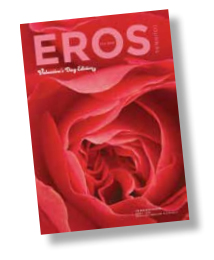By Jarryd Bartle
At Eros, not a week goes by without some budding young man asking us about entering the porn industry. If they don’t think they’ll get in as a performer, the next big idea is to start their own production company.
But what is the legal status of pornography in Australia? Unfortunately, the answer is quite out of step with community expectations.
The Australian Classification Regime
Let’s start with the basics – most forms of media that are to be sold, exhibited or distributed in Australia (publications, films and games) must first be classified by the Australian Classification Board.
‘Films’ are classified as either G, PG, M, MA15+, R18+ or X18+ and ‘Publications’ such as magazines are classified as either Unrestricted, Category 1 (restricted) or Category 2 (restricted).
If a film or publication does not fit a classification criteria, it gets labelled as ‘Refused Classification’ or ‘RC’.
If a piece of media is RC it is illegal to sell, exhibit or distribute the media in Australia. Even if the Australian Classification Board hasn’t formally rejected a piece of media, if something is ‘likely’ to be labelled RC it is still illegal to commercialise the media.
A variety of Federal, State and Territory regulatory offences apply for not complying with the classification regime.
Classification and Sexually Explicit Material
So how is pornography classified?
If we take ‘pornography’ to mean ‘depictions of actual sexual activity’ then such media can only be classified as either ‘Category 2 (restricted)’ if a publication, or ‘X18+’ if a film.
Category 2 (restricted) publications must only be sold in age-restricted sections of premises, with various State and Territory laws applying to display, packaging and advertising.
Films classified X18+ cannot have wide release in Australia and can only be sold and exhibited in the Northern Territory and the Australian Capital Territory under compliance with strict local laws.
Nevertheless, under the current wording of the Classification Guidelines many forms of pornography depicting non-violent, consensual sex are likely to be Refused Classification by the Classification Board.
Refused Classification, Sexual Minorities and Causing ‘Offence’
Under the Publication Guidelines a publication will be Refused Classification (RC) if it depicts:
‘revolting or abhorrent phenomena in such a way that they offend against the standards of morality, decency and propriety generally accepted by reasonable adults’.
Where ‘revolting or abhorrent phenomena’ is defined as ‘fetishes or practices, sometimes accompanied by sexual activity, which are considered offensive’. Furthermore, ‘fetish’ is defined under the Publication Guidelines as:
[A]n object, an action, or a non-sexual part of the body which gives sexual gratification. Mild fetishes include stylised domination and rubberwear. Stronger fetishes include bondage and discipline.
A ban on ‘fetishes’ also exists under the Film Classification Guidelines, which has a much broader definition including ‘body piercing, application of substances such as candle wax, ‘golden showers’, bondage, spanking or fisting’.
Films will also be RC if they ‘demean’ any person depicted which refers to ‘a depiction or description, directly or indirectly sexual in nature, which debases or appears to debase the person or the character depicted’.
The broad terms used in the Classification Guidelines are arguably discriminatory against queer or otherwise sexually adventurous communities whose fantasies do not fit the social mores of “reasonable adults”.
The Classification Guidelines have also been used to refuse classification or censor pioneering art-house films that depict real sexual activity or transgress social norms. These include works by notable queer and transgressive filmmakers such as Bruce LaBruce (LA Zombie), Greg Araki (Mysterious Skin), John Waters (Pink Flamingos) and Larry Clark (Ken Park).
Pornography Production
There are a handful of adult media production companies currently operating in Australia. However, budding porn producers have to manoeuvre within a stringent and confusing regulatory framework.
It is prohibited to produce material likely to be classified as X18+ or Refused Classification in all States and Territories except the Australian Capital Territory, where X18+ production isn’t formally banned.
The ACT has never formally legalised production. Instead, a licensing scheme exists for the copying and distribution for X18+ classified material.
Furthermore, there is a lot of ambiguity regarding adult media production in the ACT, including its relationship to laws covering sex work.
Due to the stringency of existing production laws many adult media producers either choose to film their material overseas or act in non-compliance with existing laws.
Online Regulation
Unsurprisingly, Australia’s classification regime is having a difficult time managing the rise of online pornographic content.
The eSafety Commissioner is the central agency for regulating internet content in Australia. The Commissioner receives complaints regarding internet content and requests Australian-based internet service providers (ISPs) to remove content that does not comply with their standards.
Websites which depict media that could be classified as X18+ or RC can be subject of a complaint to the Commissioner and therefore run the risk of having an Australian ISP de-list their website. The Commissioner can also remove R18+ classifiable material in some circumstances.
As a result, many Australian production companies wishing to start an adult website do so via an international server that is not within the jurisdiction of the Commissioner.
Conclusion
Despite the proliferation of pornography on the internet, Australian laws still appear to be trying to outlaw and shelter the public from depictions of non-violent, consensual sex between adults.
The current legal landscape poses troubling questions regarding State censorship, sexual minority rights and free expression that should be more openly discussed by lawmakers and the general public alike.
Depictions of actual sexual activity between consenting adults are not inherently ‘offensive’ or ‘obscene’ and its time our classification laws reflected the expectations of the community more broadly.























